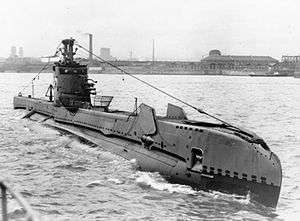HMS Saracen (P247)
 HMS Saracen on the River Mersey in July 1942 | |
| History | |
|---|---|
| Name: | HMS Saracen |
| Builder: | Cammell Laird & Co Limited, Birkenhead |
| Laid down: | 16 July 1940 |
| Launched: | 16 February 1942 |
| Commissioned: | 27 June 1942 |
| Identification: | Pennant number P247 |
| Fate: | Sunk on 14 August 1943 |
| General characteristics | |
| Class and type: | S-class submarine |
| Displacement: |
|
| Length: | 217 ft (66 m) |
| Beam: | 23 ft 6 in (7.16 m) |
| Draught: | 11 ft (3.4 m) |
| Speed: |
|
| Complement: | 48 officers and men |
| Armament: |
|
HMS Saracen was an S-class submarine of the Royal Navy, and part of the Third Group built of that class. She was built by Cammell Laird and launched on 16 February 1942.
Career
Her first pennant was P213, to which her commissioning crew objected because of the unlucky connotations of 13, so the Admiralty changed it to P247 (which still added up to 13). She started her wartime career in home waters (Lieut. M. G. R. Lumby in command), where she sank the German submarine U-335 southeast of the Faroe Islands (in the North Sea) on 3 August 1942. There were only two survivors out of a crew of 44, one of whom drowned shortly afterwards after refusing to be rescued, the other being taken prisoner.[1]

She then served in the Mediterranean, where she sank the Italian submarine Granito, the Italian auxiliary submarine chaser V 3 / Maria Angelette, the French tugs Provincale II and Marseillaise V, the Italian merchant ships Tagliamento and Tripoli and the German merchant vessel Tell. She also attacked and damaged two sailing vessels and the French (in German service) tanker Marguerite Finally. She also attacked a number of convoys, torpedoing and sinking the Italian merchant ship Francesco Crispi. Saracen had less luck attacking other convoys, firing three torpedoes against one made up of the small Italian tanker Labor, the German merchantman Menes, which were escorted by the Italian torpedo boats Calliope and Climene. All torpedoes fired missed their targets. On another occasion, she fired four torpedoes against the German transport ship Ankara and one of her escorts, the Italian destroyer Camicia Nera. Again, all torpedoes fired missed their targets.[2]
Sinking
Shortly after midnight on 14 August, whilst on patrol off Bastia, Saracen was spotted by the Italian corvettes Minerva and Euterpe which attacked with depth charges at 46 minutes past midnight (according to the Captain of the Minerva, Lt. Mario Baroglio in his report held in the National Submarine Museum Gosport). According to the official report submitted to the Admiralty (Submarines) by Lt- Lumby, the attack commenced at 0100 hours and a quarter of an hour later she was forced to surface. He gave the order to abandon ship and scuttled the boat to avoid her capture. Two crew members lost their lives as they abandoned ship.
Wreck Discovery
In 2015, the wreck of Saracen was discovered and photographed on the seabed, at a depth of 1,385 feet (422 m) off the coast of Corsica.[3]
Notes
- ↑ "Abrupt end to U-335′s first patrol". World War II Today. Retrieved 3 August 2012.
- ↑ "HMS Saracen (P 247)". uboat.net. Retrieved 16 May 2015.
- ↑ Allen, Peter (22 June 2015). "Royal Navy submarine which was scourge of the Nazis and scuttled off the coast of Corsica is finally discovered 72 years later". Daily Mail. Retrieved 23 June 2015.
References
- Colledge, J. J.; Warlow, Ben (2006) [1969]. Ships of the Royal Navy: The Complete Record of all Fighting Ships of the Royal Navy (Rev. ed.). London: Chatham Publishing. ISBN 978-1-86176-281-8. OCLC 67375475.